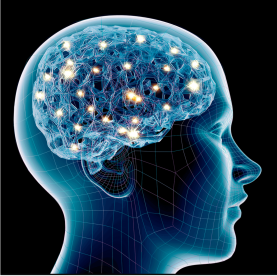Brain Networks
The BRAIN functions via NETWORKS of neurons.
OLD THINKING: Early ideas about the BRAIN came from anatomical dissection. This dissection identified regions which were named as separate parts – and early research identified certain functions attributed to those brain parts.
NEW THINKING: Recent research (especially since development of the functional MRI - fMRI) has determined that a key way that the Brain processes information and responds is through NETWORKS. A nerve cell (neuron) or brain area can belong to multiple NETWORKS.
NETWORKS involved in memory, thoughts and emotions identified so far include:
- DMN = Default Mode Network – involved in thinking about oneself, autobiographical memory and social cognition. Usually active at rest when reflecting or thinking about future events.
- SN = Salience Network – involved in detection and integration of “salient” internal-external stimuli as well as autonomic and emotional regulation, and conflict monitoring. The SN includes several areas including the amygdala and thalamus. The SN is felt to regulate the dynamic interplay between the DMN and CEN.
- CEN = Central Executive Network – involved in working memory and executive functioning. The CEN is usually engaged during tasks requiring attention and inactive at rest.
RESOURCES
Bassett and Sporns (2017) Network neuroscience. Nat Neurosci. Network neuroscience proposes to tackle these enduring challenges. Approaching brain structure and function from an explicitly integrative perspective, network neuroscience pursues new ways to map, record, analyze and model the elements and interactions of neurobiological systems.
Misic and Sporns (2016) From regions to connections and networks: new bridges between brain and behavior. Curr Open Neurobiol This review traces the trajectory of network neuroscience, focusing on how connectivity patterns can be related to cognition and behavior.
Gu (2015) Emergence of system roles in normative neurodevelopment. PNAS Dynamic maturation of network modules in youth may be a critical driver for the development of cognition
RESOURCES - Trauma and Brain Networks
Webb (2022) Racial Discrimination and Resting-State Functional Connectivity of Salience Network Nodes in Trauma-Exposed Black Adults in the United States. JAMA Psychiatry. Study of 102 Black adults demonstrated that more experiences of racial discrimination were assocciated with altered connectivity, even after adjusting for lifetime trauma exposure. Experiencing racial discrimination is associated with modifications of vigilance suggesting a mechanism by which racism affects mental health.
Yang (2022) Functional connectome mediates the association between sleep disturbance and mental health in preadolescence. Hum Brain Mapp Sleep disturbance is known to be associated with various mental disorders and often precedes the onset of mental disorders in youth. This study found abnormalities in connectivity in youth correlated with both sleep problems and mental disorders.
Lebois (2021) Large-Scale Functional Brain Network Architecture Changes Associated With Trauma-Related Dissociation. Am J Psychiatry. Trauma-related dissociative symptoms, distinct from PTSD and childhood trauma, can be estimated on the basis of network connectivity. Furthermore, between-network brain connectivity may provide an unbiased estimate of symptom severity, paving the way for more objective, clinically useful biomarkers of dissociation and advancing our understanding of its neural mechanisms.
Terpou (2020) The hijacked self: Disrupted functional connectivity between the periaqueductal gray and the default mode network in posttraumatic stress disorder using dynamic causal modeling. Neuroimage Clin. Self-related processes are mediated by the default mode network (DMN), which, critically, shows altered functionality in individuals with posttraumatic stress disorder (PTSD).
Webb (2020) Acute Posttrauma Resting-State Functional Connectivity of Periaqueductal Gray Prospectively Predicts Posttraumatic Stress Disorder Symptoms. Biol Psychiatry Cogn Naturosci Neuroimaging. The brain's periaqueductal gray (PAG), generates behavioral responses to physical and psychological stressors and threat processing. This study found that altered PAG resting-state functional connectivity (RSFC) prospectively predicted PTSD symptoms.
Lanius (2015) Restoring large-scale brain networks in PTSD and related disorders: a proposal for neuroscientifically-informed treatment interventions Eur J Psychotraumatol Describes three intrinsic connectivity networks in the brain, namely the central executive, salience, and default mode networks, identified as crucial to the understanding of higher cognitive functioning - and how the functioning of these networks are impaired in psychopathology, including posttraumatic stress disorder (PTSD)
test


